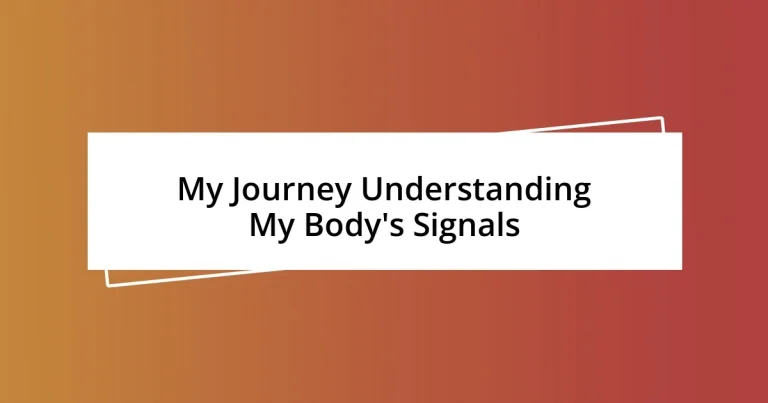Key takeaways:
- Understanding and acknowledging body signals can lead to better self-care and recognition of emotional connections influencing physical well-being.
- Developing mindfulness practices, such as breathing exercises and daily emotional check-ins, enhances awareness of mental and emotional states.
- Creating healthy habits, centered on nutrition, exercise, and sleep, fosters improved overall health and transforms well-being routines into enjoyable activities.
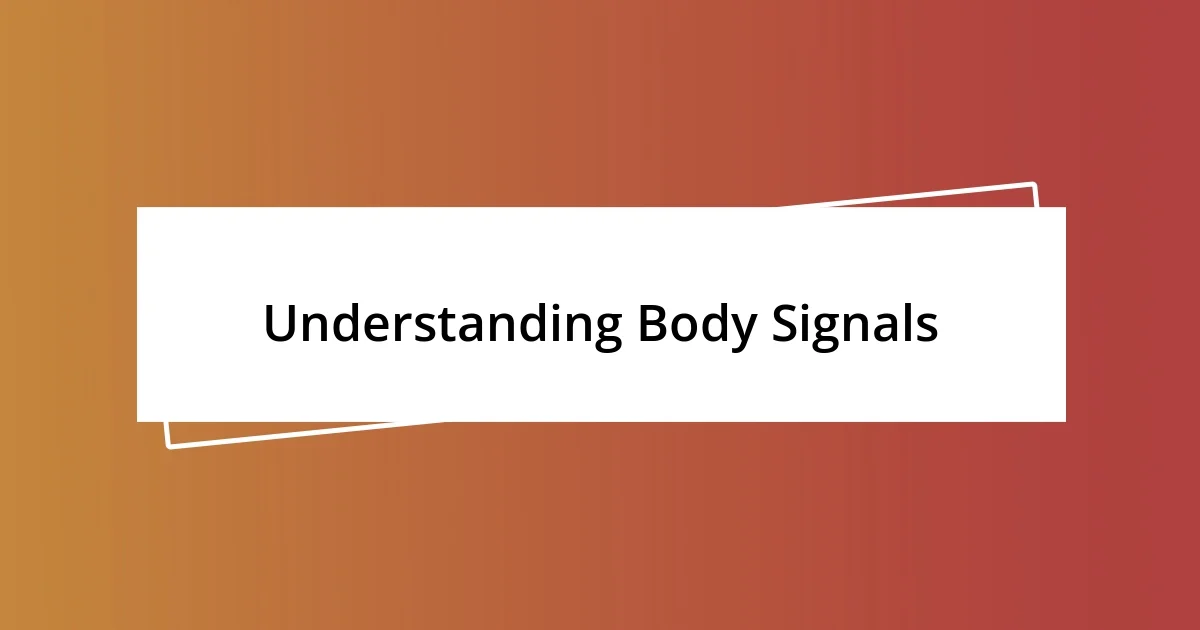
Understanding Body Signals
Understanding body signals is a journey that often goes unnoticed until we face discomfort or illness. I remember the time I felt persistent fatigue, which I initially brushed off as just a busy schedule. Looking back, I realize my body was signaling that it needed more rest and self-care—something I wish I had acknowledged sooner.
Have you ever felt a knot in your stomach before an important presentation? I certainly have. That tightness wasn’t just nerves; it was my body communicating anxiety, urging me to pause and breathe. The more I tuned into these sensations, the better I became at distinguishing between physical and emotional signals.
Our bodies are surprisingly articulate when we learn to listen. There was a period when I ignored my headaches, attributing them to stress. One day, I decided to take a few moments to close my eyes and check in with myself. That simple act revealed a deep-seated tension in my shoulders—my body’s way of saying, “You’re carrying too much.”
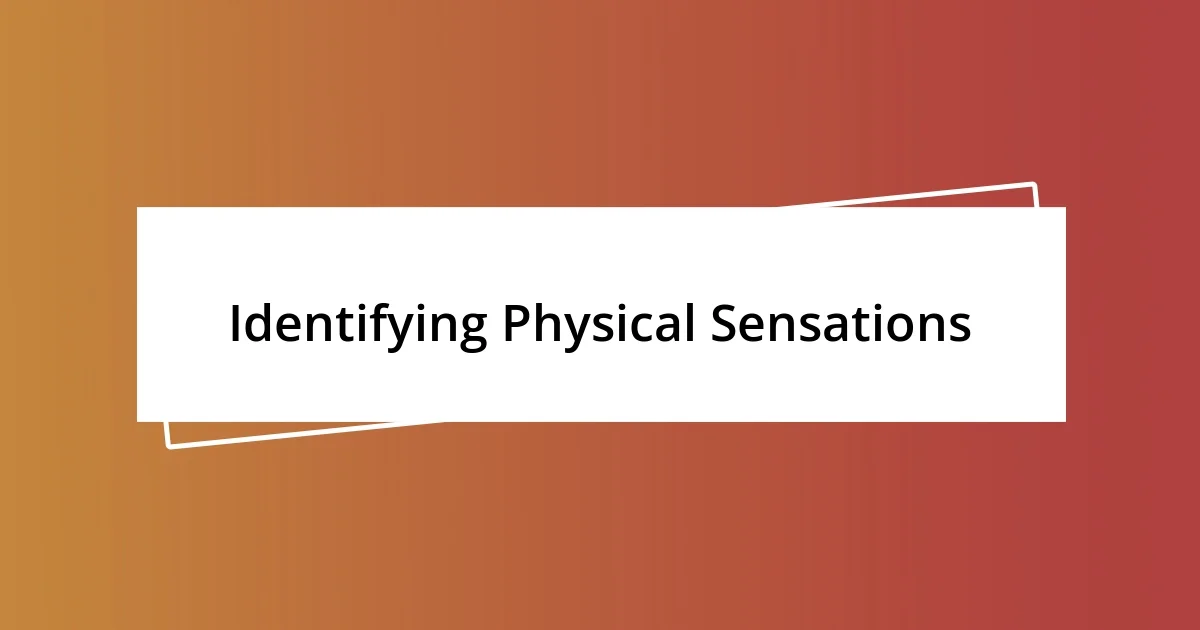
Identifying Physical Sensations
Recognizing physical sensations is like learning a new language, where every ache or tightness has its own meaning. For example, I once felt a sharp pain in my lower back after a day of sitting at my desk. It wasn’t just discomfort; it was my body crying out for better posture and movement. This experience taught me to pay attention and respond actively to the signals my body sends.
Here are some common physical sensations to look out for and what they may indicate:
– Tension in shoulders or neck: Often ties to stress or anxiety.
– Stomach discomfort: Can signal hunger, stress, or even intuition about a situation.
– Fatigue: A clear sign that your body needs rest or a break from activity.
– Increased heart rate: Might indicate excitement, fear, or physical exertion.
– Headaches: Often a reflection of dehydration, tension, or emotional strain.
Each sensation is a conversation starter with ourselves; recognizing them can lead to profound insights about our well-being. I remember another moment when an inexplicable heaviness settled in my chest. After sitting with that feeling and breathing deeply, I realized it stemmed from unresolved emotions that needed addressing. It was a simple yet powerful reminder of how intricately our bodies and emotions are connected.
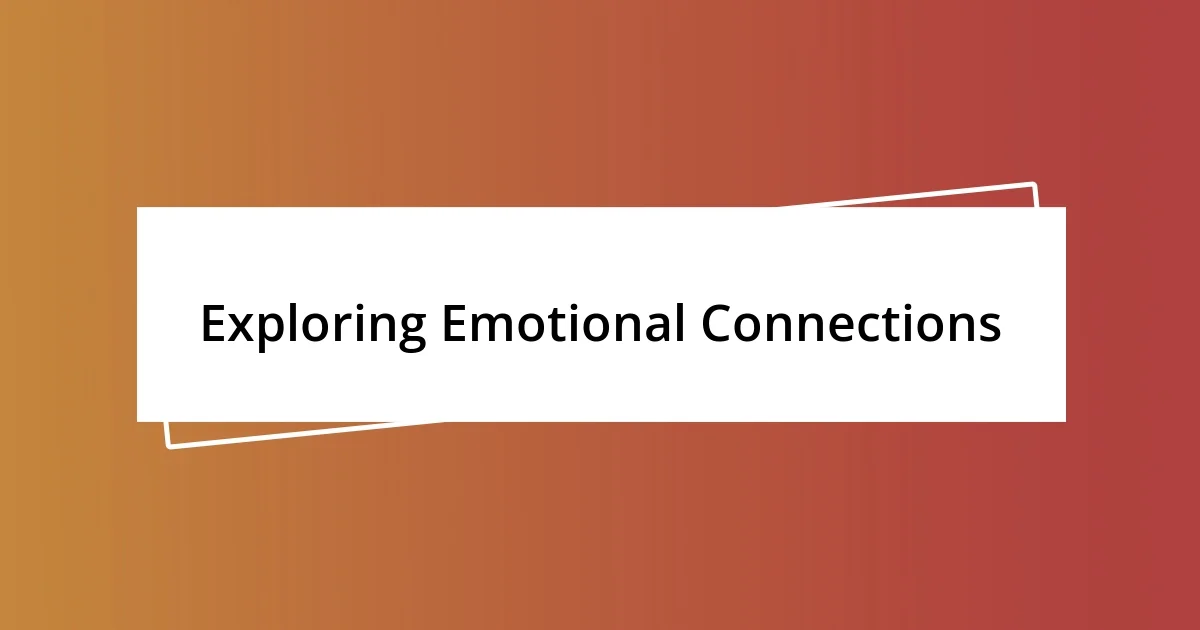
Exploring Emotional Connections
Exploring emotional connections can be eye-opening. I recall an instance when I erupted in anger over a minor inconvenience, like a spilled drink. Later, I understood that my reaction wasn’t solely about the spill; it was a build-up of frustration from other areas of my life that I hadn’t acknowledged. This moment highlighted how our emotions can manifest physically and how crucial it is to understand the root cause behind them.
One day, while preparing for a family gathering, I felt overwhelming dread—like a heavy blanket had been thrown over me. It took me a while to connect this feeling with my anxiety about family dynamics and unspoken tensions. By recognizing this emotional connection, I was able to engage in self-reflection and approach the situation with more confidence. This realization clarified why I sometimes felt physically drained after such events, reinforcing the idea that our emotional states significantly impact our physical well-being.
I believe that developing a deeper awareness of our emotional landscape empowers us to make healthier choices. For instance, after a long week of work, I noticed me feeling restless and irritable. Instead of ignoring this unease, I scheduled a quiet evening at home with a good book. It turned out to be a nurturing decision that allowed me to recharge, illustrating how listening to our emotional signals can lead to restorative practices.
| Emotional Signal | Possible Physical Manifestation |
|---|---|
| Stress | Tight shoulders or neck pain |
| Anxiety | Butterflies in the stomach |
| Frustration | Increased heart rate or headaches |
| Sadness | Fatigue or heaviness in the chest |
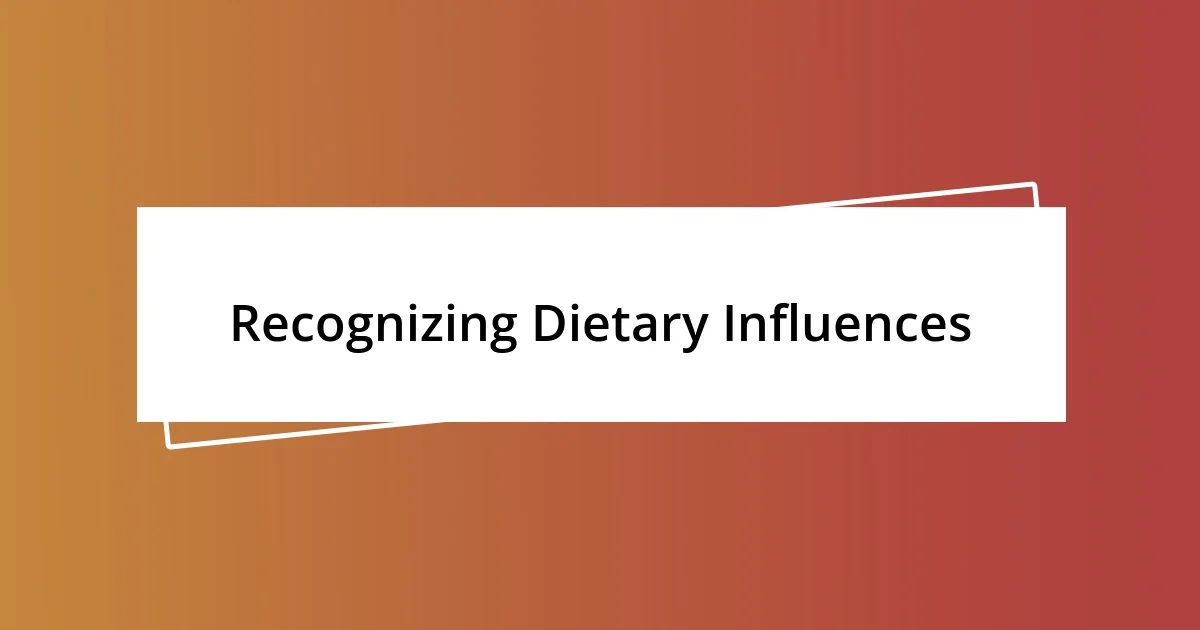
Recognizing Dietary Influences
When I delve into recognizing how my diet influences my body, I often reflect on the times I felt unusually lethargic after indulging in fast food. The heavy feelings in my stomach were not just a coincidence; they were my body pushing back, reminding me to consider more wholesome options. Have you ever noticed how specific foods can lead to physical discomfort? It’s fascinating how our choices can send such clear signals.
Once, I experimented with eliminating sugar from my diet for a month. At first, I experienced cravings and irritability, but eventually, those feelings transformed into a lightness I hadn’t anticipated. This change made me realize that my body thrives on natural, nutrient-dense foods, and now, I consciously seek out colorful fruits and vegetables, which provide both energy and clarity. It’s remarkable how something as simple as what we eat can shift our mental and physical states.
I also remember a gathering where I indulged in a rich dessert that I typically avoided. The short-lived pleasure quickly turned into regret, manifested in an uncomfortable bloating that made me question my choices. This experience reinforced the importance of listening to my body’s signals. Each time I indulged in something that didn’t serve me, I learned to tune in more closely to the lessons my body was sharing. How often do you pause to evaluate how meals make you feel? Trust me, that reflection can lead to more thoughtful eating habits and overall well-being.
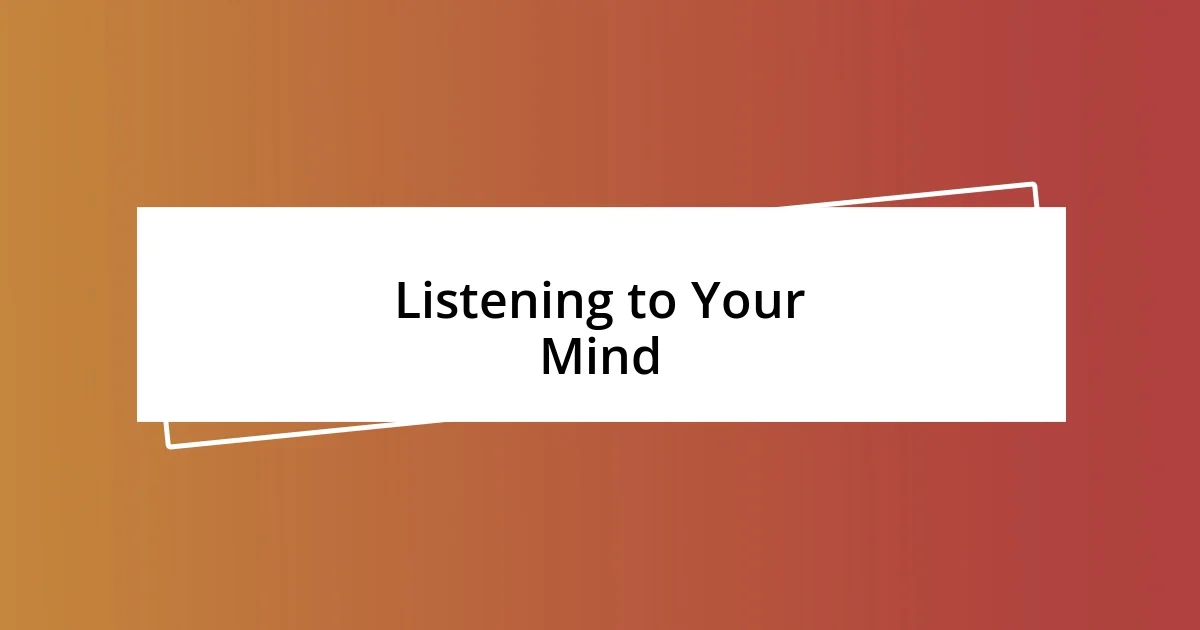
Listening to Your Mind
When I think about listening to my mind, I can’t help but recall a day when I felt completely lost in a fog of stress. It was one of those mornings where everything felt off; my to-do list loomed over me, and all I wanted to do was crawl back into bed. I decided to sit quietly for a moment, just to check in with myself. That stillness opened a floodgate of thoughts, making me realize how exhausted I had been mentally, not just physically. Have you ever experienced that nagging feeling that you’re just going through the motions? I learned that day how critical it is to take a mental pause and recognize my mind’s need for space.
One time, I was caught up in a cycle of self-doubt before a big presentation at work. I noticed my mind spiraling, filled with negative thoughts about my abilities. Instead of pushing those feelings aside, I took a moment to vocalize my fears out loud. Just that simple act of acknowledging what I was feeling helped me confront the negativity head-on. I found that the more I listened to my mind, the easier it became to navigate those daunting moments. How often do you give yourself permission to voice your inner thoughts? I find that this practice can be incredibly liberating and empowering.
Additionally, I distinctly remember a night when I couldn’t shake the feeling of unease that settled within me. I was preparing for a discussion that I anticipated would be confrontational. Instead of ignoring that sensation, I chose to write down my thoughts and emotions in a journal. That practice allowed me to channel my anxiety into clarity, leading me to understand the underlying worry about being misunderstood. It truly highlighted the connection between my mental state and emotional well-being. Have you ever tried this? By giving voice to what’s bubbling beneath the surface, I’ve discovered a greater sense of control over my feelings, transforming them into actionable insights.
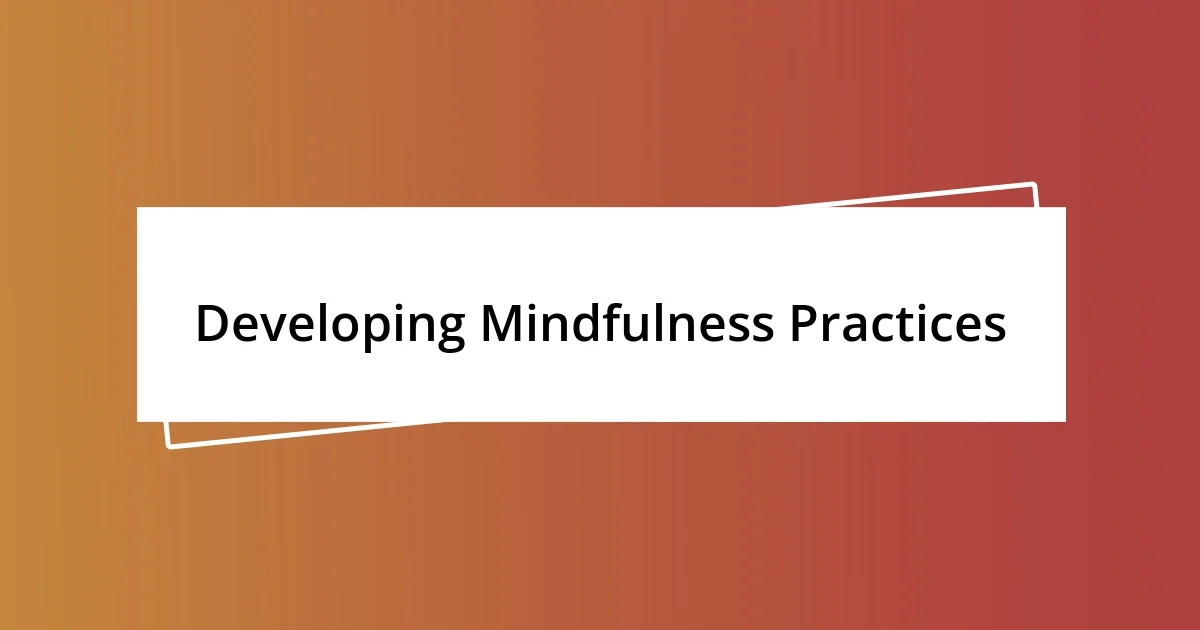
Developing Mindfulness Practices
As I began my journey into mindfulness practices, I discovered the profound impact of simply paying attention to my breath. One quiet evening, while sitting on my porch, I decided to take five minutes to focus solely on inhaling and exhaling. It might seem trivial, but that short practice grounded me, easing away the worries of the day. Have you ever noticed how just one conscious breath can shift your entire mood?
Incorporating daily check-ins into my routine has been another game changer. I recall a particularly hectic week when I felt overwhelmed. Each morning, I would pause for a moment before diving into my tasks, tuning into my emotions. This simple practice of acknowledgment helped me identify feelings of anxiety that I hadn’t even recognized. Have you tried taking a moment to assess how you’re truly feeling before your day begins? I realized that tuning into my emotional state empowers me to approach challenges with clarity and intention.
Mindfulness walks have also transformed my perspective. On a recent nature stroll, I immersed myself in the sounds around me—the rustling leaves and the chatter of birds. I felt an overwhelming sense of peace wash over me as I focused solely on the present moment. It made me wonder: how often do we rush through life, missing out on these small yet beautiful details? These walks allow me not just to connect with nature but also to connect with myself, reminding me of the importance of slowing down in our fast-paced world.
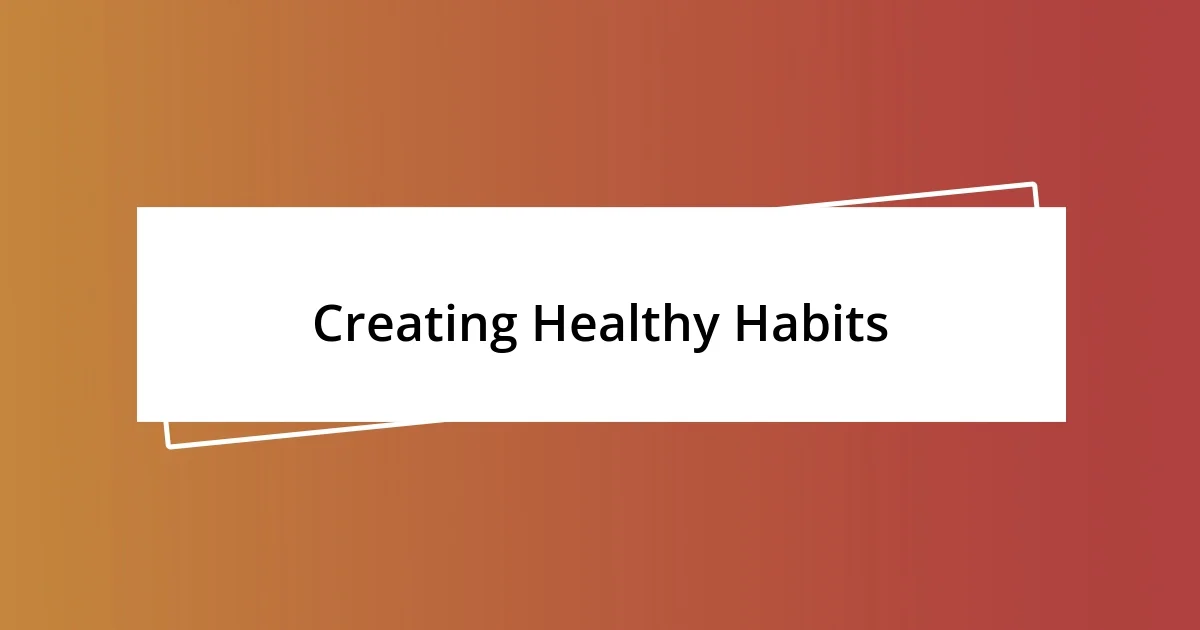
Creating Healthy Habits
Creating healthy habits requires a dedication to consistency and self-awareness. I remember the first time I tried to build a routine around my eating habits. I fed off the excitement of exploring new recipes and focusing on whole, nutritious foods. Have you ever felt that spark when you discover a meal that fuels your body? That thrill made me eager to experiment, and over time, I realized how these small changes created a foundation for better health. Instead of feeling rigidly constrained, healthy eating became a delightful exploration.
Exercise was another area I chose to nurture. Initially, I struggled to find a workout I enjoyed. Then, one afternoon, I stumbled upon a dance class that lit me up inside. I couldn’t help but smile as I moved to the rhythm, forgetting all about the stress of the day. Have you ever engaged in an activity where time just flies? That experience taught me that creating healthy habits doesn’t have to feel like a chore; it can be a celebration of movement and joy. I think the key is finding what resonates with you personally.
Moreover, I started prioritizing sleep after many nights of tossing and turning. I recall a week when I barely functioned due to fatigue. One night, I turned off all screens an hour before bed and embraced the comforting routine of reading a book instead. It was a turning point—suddenly, I was waking up refreshed and ready to take on the day. Reflecting on that change, it dawned on me: how often do we overlook the simplest actions that support our well-being? Sleep became not just a necessity, but a cherished ritual.











